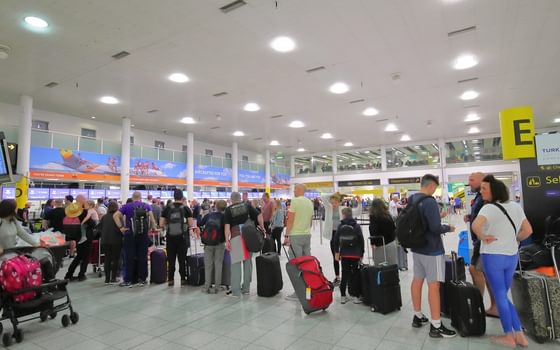Heathrow third runway could shift £43bn GDP to London and the south-east
Up to 27,000 jobs to relocate to London and the south-east from UK’s other regions if airport expanded
25 February 2020
Wider regions of the UK could lose £43bn out of their economies as 27,000 jobs move to London and the south-east as a result of the Heathrow third runway expansion, according to new research from the New Economics Foundation (NEF) published today. The report also shows the expansion would introduce an additional 3 to 4 million tonnes of carbon dioxide equivalent into the economy, equivalent to 100,000 jobs in the manufacturing sector.
In the run up to the new Government’s first Budget, at which they have promised to “level up” the economic performance of struggling towns in northern England and the Midlands, the report examines the impact of expanding London’s largest airport through a north-west runway (NWR) on the UK’s other regions and nations using a combination of NEF analysis of official Department for Transport (DfT) modelling and new data accessed via three Freedom of Information (FOI) requests. It finds a significant ‘Heathrow effect’, which has the potential to inflict serious damage on economies outside of London and the south-east, and argues that in light of this, the third runway extension should be cancelled.
On the economic impact on UK nations and regions the report finds:
- By 2050 17 million fewer passengers will be departing from non-London airports compared to the forecasts without Heathrow expansion.
- This could result in up to 27,000 jobs relocating from the UK’s wider regions to London and the south-east. The report estimates that around half of these are jobs not directly associated with the aviation sector.
- The worst-hit region is likely to be north-west England which, according to the analysis, could lose 5 million passengers and as many as 15,000 jobs by 2050.
The report also looks at the impact of Heathrow expansion on the UK’s regions and nations in the context of the climate emergency, and found:
- With Heathrow expansion, UK aviation would be on course to overshoot the carbon budget set for the sector by the Committee on Climate Change by more than 50%, and that many of the likely steps to compensate for this overshoot will impact disproportionately on the UK’s wider regions.
- Expansion at Heathrow would effectively transfer £3.3bn worth of emissions out of other regions and nations of the UK and into London between 2030 and 2050. The UK has a limited ‘budget’ of carbon emissions to stay within its targets. Expanding Heathrow would mean that London and the south-east use a greater share of the carbon budget, penalising other sectors of the economy in poorer parts of the UK.
- Expanding Heathrow would introduce an additional 3 to 4 million tonnes of carbon dioxide equivalent (MtCO2e) into the economy. This is equivalent to up to 100,000 jobs in manufacturing, or 50,000 jobs in transport and storage.
- If a flat carbon or aviation fuel tax were introduced to manage the growth in emissions, eight times more jobs could be lost outside of London and the south-east than within.
The report recommends a progressive approach to curbing aviation demand, such as NEF’s Frequent Flyer Levy. As of 2016, around 80% of the richest 5% of households had taken a flight, while only 30% of the poorest 5% had flown. Among the highest earners frequent flyers are common, and around 30% of people who earn over £230,000 fly between 12 and 47 times a year. A disproportionate number of those who might be classed as ‘frequent flyers’ live in London and the south-east.
The report also calls on MPs from outside London and the south-east of England, who overwhelmingly supported plans to expand Heathrow, to re-examine their decision and cancel the expansion.
Dr Alex Chapman, researcher at the New Economics Foundation, said:
“When the decision to approve Heathrow expansion went in front of parliament, MPs were given virtually no information on the distribution of costs and benefits across the UK’s wider regions. Our three Freedom of Information requests show that the Department for Transport could, and should, have given a far more detailed picture.
“We already know that expanding Heathrow throws fuel on the fires of the climate emergency. This new data shows it is also likely to drive regional inequality in the UK economy – the very opposite of levelling up. Heathrow expansion moves jobs and productivity to London and the south-east and, in a carbon capped world, it also threatens our ability to deliver a just transition for workers. With the majority of workers in other carbon intensive sectors based outside London and the south-east, this represents a double blow to the regions.”
Notes
The full research is available at https://neweconomics.org/2020/02/baggage-claim
The New Economics Foundation is a charitable think tank. We are wholly independent of political parties and committed to being transparent about how we are funded.
NEF was commissioned to undertake independent research and analysis into the regional financial and carbon impacts of Heathrow airport expansion by the No Third Runway Coalition. We undertook to examine available Department for Transport (DfT) data, including that which we could obtain using Freedom of Information (FOI) requests and to develop our own analytical models to understand the impact of that data and assumptions on UK regions and nations. This work was completed entirely independently of the Coalition.
The costs and benefits of the scheme to expand Heathrow airport, as presented in the National Policy Statement and voted on by MPs, are found in the Updated Appraisal Report: Airport Capacity in the South-east. The data underpinning our calculations is derived primarily from the DfT’s 2017 Aviation Forecasts, and three FOIs (referenced: F0017657, P0017641, P0017549). Our headline job and GDP impact estimates derive entirely from data provided by the DfT, and follow the DfT’s stated methodology.
A key point to note is that all of the forecast changes, or impacts, refer to changes against the sector baseline. In this case, the sector baseline, as established in the DfT’s aviation forecasts, involves sector growth. As such, our job estimates, shown in Table 1, are not job losses compared to today, they are job losses compared to how many jobs the region would otherwise have had under the baseline scenario. This same feature applies to our calculations of GDP relocation.
Table 1: Jobs relocated to/from the UK’s regions as a result of a Heathrow NWR

Source: DfT jobs modelling outputs accessed via FOI Ref: P0017641
All of our findings are broken down into the regions and nations of the UK. Aviation statistics often refer to the ‘London Airport System’ – Heathrow, City, Gatwick, Stansted and Luton. In 2018 the London airport system (Heathrow, City, Gatwick, Stansted and Luton) accounted for 59% of the UK’s air passenger movements, and 78% of freight handled. However, to make use of jobs data collected in the Business Register and Employment Survey (BRES), we need to reflect its geographies. When discussing employment figures we therefore refer only to Heathrow and City when discussing ‘London’. Stansted and Luton are part of the east of England, and Gatwick is in the south-east. There is some blurring as, for example, a large number of workers at Heathrow live in the south-east region. As such where presenting model outputs we present London and the south-east as a separate grouping. Table 2, below, shows our headline GDP impact estimates. It is important to note that these represent net present values of changes over the period 2019 – 2084/85.
Table 2: The Net Present Value (2019 – 2084/85) of GDP relocated due to shifts in the location of employment resulting from Heathrow Expansion

Source: Calculations based on DfT modelling and guidance and FOI ref: P0017641
The figures showing that by 2050 17 million fewer passengers will be departing from non-London airports were found through analysis of the DfT’s aviation modelling.
The figures showing that this could result in up to 27,000 jobs relocating were found through analysis of DfT data accessed via FOI.
The figures showing that expanding Heathrow would introduce the carbon dioxide equivalent to up to 100,000 jobs in manufacturing, or 50,000 jobs in transport and storage use 2017 levels of carbon intensity per job in those sectors.
Data showing that the highest earners are the most frequent flyers is from various government datasets analysed by Fellow Travellers, in Runway for the few. Available at http://afreeride.org/wonkery/
Campaigns Stop airport expansions
Topics Climate change






